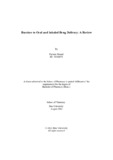Barriers to oral and inhaled drug delivery: a review
Abstract
Oral and pulmonary routes of drug administration are the two most common modes to deliver drugs to patients owing to their non-invasive nature. Among the two, the oral route is still the most preferred one due to a number of advantages such as ease of administration without requiring any assistance that offers enhanced patient compliance and cost-effectiveness. Several factors affect absorption orally delivered drugs including drug solubility, permeability across the mucosa, and stable position in the gastrointestinal tract environment. It is fundamental to understand the physicochemical, biochemical, metabolic and biological barriers which limit the overall bioavailability of therapeutic agents to address the problems associated with decreased oral absorption and bioavailability. Pulmonary route of drug administration holds the potential to overcome these problems of reduced absorption associated with oral drug delivery. However, pulmonary drug delivery is also negatively affected by mechanical, chemical, immunological barriers along with behavioral barriers linked with use of inhaler devices and poor patient adherence. To this end, the present review discusses the barriers associated with oral and pulmonary drug delivery, along with highlights of the advantages and disadvantages of both routes of drug administration with future perspectives.

